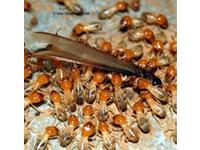Confused Flour Beetle (Also see Rust-Red Flour Beetle)
Granary Weevil (Also see Rice Weevil)
Mediterranean Flour Moth or Mill Moth
Red-legged Ham or Copra Beetle
Rice Weevil (Also see Granary Weevil)
Rust-Red Flour Beetle (Also see Confused Flour Beetle)
Tropical Warehouse or Almond Moth (Also see Warehouse, Tobacco or Cocoa Moth)
Warehouse, Tobacco or Cocoa Moth (Also see Tropical Warehouse or Almond Moth)

Appearance
Adults 3-4mm, workers creamish white with brown head; soldiers with brown head and large jaws (mandibles), sometimes modified into a specialised “spout” through which they squirt a foul smelling liquid on attackers.
Life Cycle
Queen lays thousands of eggs which are looked after by workers. Most eggs hatch into sterile workers and a few become soldiers and males. During favourable conditions, large numbers of reproductives swarm to form new colonies.
Notes
Often (mistakenly) called 'white ants', live in colonies consisting of workers, soldiers and king and queen. Subterranean termites live below the ground and construct mud tubes from the nest to food source – these tubes are a sure sign of infestation. Wood-nesting termites excavate nests in wood and leave behind characteristic signs of infestation – their pellet shaped frass or droppings. Large numbers congregate just before the rainy season to swarm – females and males fly off, mate and female then starts a new colony. Feed on dead/decaying wood, and can cause great (unseen) damage if not detected in time.

